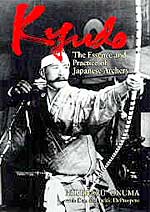Book Review
Kyudo: The Essence and Practice of Japanese Archery
by Hideharu Onuma, with Dan and Jackie DeProspero.

Review by Meik Skoss
It's not often that one has the opportunity to review a book that is
the definitive work in its field, but I got lucky. Kyudo is one such.
Hideharu Onuma Sensei was the 15th-generation headmaster of a classical
archery tradition, the Heki-ryu Sekki-ha, and at the time of his death
in 1990 was a hanshi kyudan (9th dan), one of the most senior teachers
of modern kyudo. The DeProsperos have lived and studied kyudo and aikido
in Japan for more than a dozen years, much of that time living with their
teacher. Dan DeProspero is a renshi rokudan (6th dan), an authorized
kyudo instructor, and his wife, Jackie, is the first non-Japanese woman
to be promoted to the rank of godan (5th dan) in the art. The text of
Kyudo was written by the DeProsperos, but the words and spirit are largely
those of Onuma Sensei. This book is a fitting tribute to their teacher
and an example of their deep devotion and thorough knowledge of kyudo
in particular and the Japanese martial arts in general.
The book begins with a discussion of what kyudo is and why people pursue
it as a lifelong study. The art of Japanese archery is seen as a means
of directly experiencing, thence understanding, truth, goodness, and
beauty through shugyo, the austere training of spirit, mind and body,
using the bow as a vehicle and one's Self, as the target. Chapter Two
is a succinct discussion of the history and development of kyudo, beginning
with the prehistoric period and continuing to the foundation of the All-Japan
Kyudo Federation. The third chapter deals with the spirit of kyudo. It
examines the manner in which the cognitive mind, or shin (kokoro), combines
with vital energy, ki, producing the self-control and emotional stability
essential to proper technique. The next two chapters are detailed descriptions
of the archery range and equipment used in the art of kyudo. The technical
core of the book is contained in Chapters Six, Seven and Eight. Chapter
Six is entitled "Hassetsu: The Eight Stages of Shooting." Chapter
Seven deals with "The Technique and Practice of Kyudo." Although
no book can substitute for practicing under the direct supervision of
a competent teacher, the explanations and illustrations in this section
are of such high quality that many readers may well be tempted to try
to do so, and come close to succeeding. They are that good. The last
chapter is "Problem Solving." For the dedicated archer, these
three chapters alone are worth the cost of the book. They sum up years
of training in a manner that is easy to understand, give a wealth of
information, and never overload the reader with too much detail.
The appendix is another feature of this book that makes it an important
reference for everybody who is interested in martial disciplines in particular
or Japanese culture in general. Entitled "Shitemon_do: Student-Teacher
Conversations," it is a series of talks that the DeProsperos had
with Onuma Sensei over a period of several years and covers a variety
of subjects ranging from the purpose of training in kyudo (or any martial
art or way), the way budo training changes its practitioners, the mental
processes and attitudes involved in training, to some of the aesthetic
and philosophic principles intrinsic to the martial arts. Regardless
of the particular discipline that one studies, the topics covered in
these conversations are of immediate bearing to all budoka and should
prove invaluable in their training. A brief bibliography and a directory
of kyudo dojo and organizations all over the world follow the appendix
and provide the interested reader with means of further study and investigation
of Japanese archery.
In closing, just a few more words: Buy This Book!!
Reproduced with permission of Meik Skoss and Koryu
Books.
Copyright ©1993 Meik Skoss. All rights reserved.
This review orignally appeared in Aiki News #96,Vol.20,no.2., Summer/Fall
1993
and also appears on the website of Diane & Meik Skoss: http://www.koryubooks.com
Kyudo: The Essence and Practice of Japanese Archery is available from
the FightingArts Estore:

(160 p., 7½ x 10½"
hardbound., fully illustrated)
US$32.95
(+$5 shipping within US)

About The Reviewer: Meik Skoss is one of the foremost non-Japanese researchers and practitioners
of the Japanese classical martial arts; his masters degree is in Physical
Education. He began his martial arts training in 1966 in Los Angeles
and moved to Japan in 1973. During his twenty-one year stay in Japan
he received dan grades in a variety of Japanese martial arts, including
jodo, jukendo, aikido, tankendo, and atarashii naginata. He holds the
licenses of okuden mokuroku and shihan in Toda-ha Buko-ryu and sho-mokuroku
in Shinto Muso-ryu. He is also a member of the Yagyu Shinkage-ryu and
Tendo-ryu. He teaches classical martial arts at his Shutokukan Dojo in
New Jersey, and also serves on the local volunteer rescue squad. |